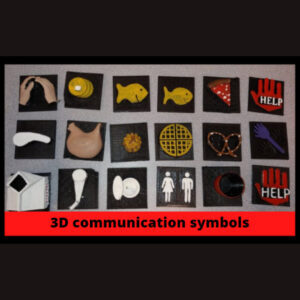
5 Things You Probably Didn’t Know About PECS®
by Lucy Hotchkiss
Given you’re looking at our blog, the likelihood is you know some basic facts about PECS. You may know that PECS (Picture Exchange Communication System®) is a picture-based Alternative Augmentative Communication (AAC) System, that there are six phases, and that it was developed by Andy Bondy, PhD and Lori Frost, MS, CCC-SLP. Or perhaps you read our last blog post and now know that PECS is an evidence-based practice suitable for a wide range of diagnoses ages, and needs. Even if you consider yourself a PECS expert, you may not know it all – here are five things you probably don’t know about PECS!
- THE PECS TEACHING PROTOCOL IS BASED ON B.F. SKINNER'S BOOK, VERBAL BEHAVIOR...
If you’ve ever taken a psychology course or had a look at our About PECS page, you’re bound to have come across the name ‘B. F Skinner’ at some point – and for very good reasons. Skinner’s research resulted in some of the most important contributions to psychology in the twentieth century. Throughout his career, Skinner wrote 21 books explaining his theories on how humans learn certain behaviours and how this learning process is impacted by consequences, termed ‘reinforcement’ and ‘punishment.’ One of these books was Verbal Behavior, in which Skinner explains the importance of understanding the effect that these consequences (created by the listener) have on both a speaker’s verbal behaviour and the development of their verbal behaviour.
The PECS protocol does exactly this – while there is an emphasis on wider functional communication skills (as opposed to only speech skills), the protocol looks at the relationship between a PECS user and their communication partner and how these functional communication skills, like requesting, can be reinforced in order to encourage a user to repeat the action in the future. An example of this is a PECS user requesting their favorite toy car to play with and then receiving the toy car from their communicative partner; the action of requesting the toy car is reinforced by receiving the toy car, resulting in the PECS user associating fun reinforcers with requests. This leads to more requests and the development of requesting as a key functional communication skill. There are nine key communication skills, more on those later.

2...AND BROAD SPECTRUM APPLIED BEHAVIOUR ANALYSIS (ABA).
Many people who implement PECS with their learners may not realize that the protocol incorporates ABA strategies. Historically, ABA has received a mixed reception. Some people may even say it is controversial based on the early work and misuse of the scientific strategies. Today, ABA is becoming much more common place in its use, with many schools and parents using the techniques to help their learners learn vital communication skills and gain independence.
ABA is a scientific approach to understanding behaviour. It looks at how behaviour is changed by the learner’s environment. Implementation must take place systematically so that those teaching can gather data regarding learner progress. ABA can be used to increase wanted behaviours, while decreasing unwanted behaviours. It is also used to maintain skills that have already been acquired, help learners to grasp new skills, and generalize their current skills so they can transfer them between activities. PECS and The Pyramid Approach to Education both use functional ABA in their method.
3. ONCE A STUDENT HAS MASTERED THE FIRST PHASE OF PECS, OTHER CRITICAL COMMUNICATION SKILLS SHOULD BE TAUGHT.
A student who has successfully learned how to make a request using PECS with their communication partner still has many vital skills left to learn. Including requesting, there are nine critical communication skills. What are the nine critical communication skills, you may ask? They are vital skills for effective communication and can be split into two categories: expressive (speaker) skills and receptive (listener) skills.
There are five expressive skills that should be taught to a student to ensure they can communicate effectively with others:
- Requesting
- Asking for help
- Asking for a break
- Indicating ‘no’ to ‘do you want ___?’
- Indicating ‘yes’ to ‘do you want ___?’
Receptive skills are used by a student to respond to the communication of others. There are four key receptive skills that a PECS user should be taught:
- Responding to ‘Wait’/Tolerating ‘No’
- Transitioning
- Following functional directions
- Following a schedule

4. PECS CAN BE USED BY PEOPLE WHO HAVE VISUAL IMPAIRMENTS.
PECS is a visually-based AAC system that depends on a user being able to discriminate between different symbols and their meanings. For example, some individuals may struggle to differentiate between symbols of “apple” and “ball” due to their similar shapes and colors. For an individual who is blind, differentiating between symbols will be impossible.

5. THE END GOAL OF PECS ISN'T SPEECH.
Research has demonstrated that the use of PECS may increase the possibility of speech development, and in some cases, a PECS user will go on to begin communicating vocally. While it is amazing when a user goes on to develop speech, it absolutely isn’t the end goal – why? The end goal of PECS is for a user to have learned functional communication skills vital to fostering their independence in daily life. A PECS user may well continue to use PECS to communicate for many years to come. They may eventually transition to a speech generating device by following a prescribed method. Or a user may develop speech, and no longer need to use PECS. If a PECS user has learned how to communicate effectively, speech is simply a by-product of the protocol and not the end goal.
Do you have questions about the PECS protocol? Join our growing online community of PECS parents, caregivers, and professionals on Facebook! Our PECS User Support Group is monitored daily by our global team of Pyramid Consultants. To become a member, search “PECS User Support” on Facebook and send a request to join!
© Pyramid Educational Consultants UK Ltd 2021
